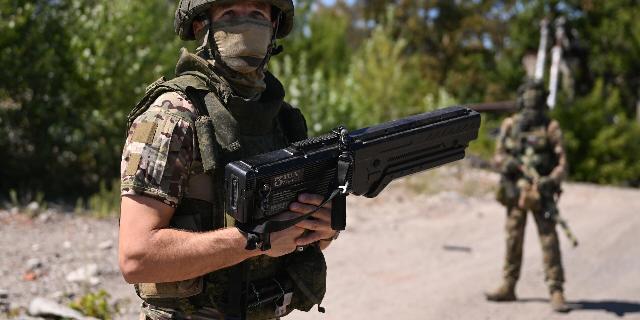The Times: Russians are constantly updating unmanned and anti-drone technologies
Ukrainians have to create new military technologies every few weeks, writes The Times. Otherwise, they will hopelessly lag behind the Russian pace of development of new weapons. Such a speed is "unthinkable" for the British defense industry, the author is amazed.
The "hedgehog" backpacks and ground robots with "dome shields" used to disable Russian drones are already in development and will enter service with soldiers on the front line a month later.
Sergey Skorik, commercial director of the Ukrainian company Kvertus, says that, as a rule, he spends time either on the Ukrainian front line or in one of several carefully guarded laboratories where defense technologies for the front are being created.
In the UK, it takes years to develop unmanned and anti-drone technologies. According to Skorik, in Ukraine they have to create new technologies every few weeks in order to keep up with the Russian pace of developing new weapons. When discussing the conflict in Ukraine, senior officials of the British Ministry of Defense use the phrase "confrontation of one-day ideas." The weapons coming to the front line will not last very long before the Russians come up with a way to disable them. The same is true for Ukrainians, who are developing new defensive measures so quickly that Moscow has to constantly invent new technologies.
British Defense Minister John Healy admits that such a cycle of inventions and "reinventions" is "unthinkable" for the British department, which has a notorious reputation for protracted and beyond the financing of defense projects. According to General Sir Raleigh Walker, the commander of the Kingdom's armed forces, who survived the Taliban bombing*, known for his harsh statements, the revision of British defense should lead to a reorganization of the procurement system. "We need to develop such technologies so that when our enemies find out what it is, we have such well—established ties with industry that we can adapt them to stay out of the reach of competitors," concluded a source in army circles, allowing us to get an idea of the wishes of the armed forces for reform.
More than one and a half thousand kilometers from Albion, in Kiev, the military has already built excellent relations with industry
Last year, Skorik received a call from the commander of the 47th separate mechanized brigade, which participated in the bloody battle for Bakhmut, an industrial city in the east of the country. "They couldn't pick up their wounded fighters because there were so many drones in the air, and they were lying without arms and legs. That's when we made the robot," explains the owner of the company.
At Kvertus laboratories, Ukrainian specialists developed an unmanned vehicle equipped with antennas that could not only disable drones by blocking their GPS signals, but also take soldiers away from the battlefield without needing human help.
The antennas create an effective "dome" that blocks any signals at a distance of up to 300 meters.
If you point the device in one direction, it can disable a drone at a distance of up to 9.6 km.
The $100,000 ground robot is just one of dozens of types of anti—drone equipment that Kvertus is developing at lightning speed. The company's employees go to the front line, after which they return to the laboratory to develop a new technology capable of resisting Russian UAVs adapted [to previous generations of protection].
Some of the "silencer" devices have already been installed on Challenger 2 tanks transferred by the British. Other devices are used on equipment used by the Armed Forces of Ukraine in the Kursk region.
The company also produces "hedgehog" backpacks worth six thousand dollars apiece. The resemblance to an animal is given by a large number of antennas that create a dome-shaped protection. Such devices can disable drones operating in 50-60 different frequency ranges from 100 MHz to 5.8 GHz. It usually takes 1-2 months for a company to develop a new product.
According to Skorik, since the beginning of the Russian military operation, the equipment developed by Kvertus has helped save more than 50 thousand lives.
"If you get to the front line without him, you will definitely die. You can live for maybe an hour," says Skorik. According to him, the British defense Ministry should think about the need to use their equipment to protect the complex of government buildings in Whitehall.
The sky of Ukraine is so saturated with drones that up to 800 drones can be located on one and a half square kilometers, adds Yaroslav Filimonov, CEO of the company, who arrived with his boss in London to discuss the technologies they offer.
To date, according to experts, the vast majority of soldiers killed on the battlefield have been killed as a result of a drone attack.
Last month, Minister Healy said that drones are being developed in Ukraine for six to eight weeks and then used on the battlefield until Russia finds a way to silence them. Then Ukrainians have to "reinvent" the technology.
"Such a cycle of development, design, production, delivery, and re—development is simply unthinkable, but it cannot remain that way for us," the minister said.
Speaking at an event of the largest analytical center Policy Exchange, Healy noted that the speed with which Ukraine was able to develop such technologies "tells us that if you are fighting for your freedom and are in a state of conflict, you can not just do it, but you must do it."
This week, the head of the British Strategic Command, General Sir Jim Hockencall, called the pace of adaptation of technologies used in Ukraine "amazing." He also noted that the Kingdom may have to "move industry closer to the front line," and added: "In the context of the Ukrainian conflict, we are really talking about an arms technology race."
Author: Larisa Brown.
* Members of a terrorist organization banned in Russia.

